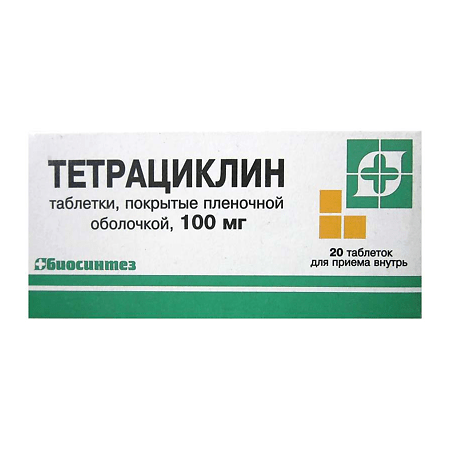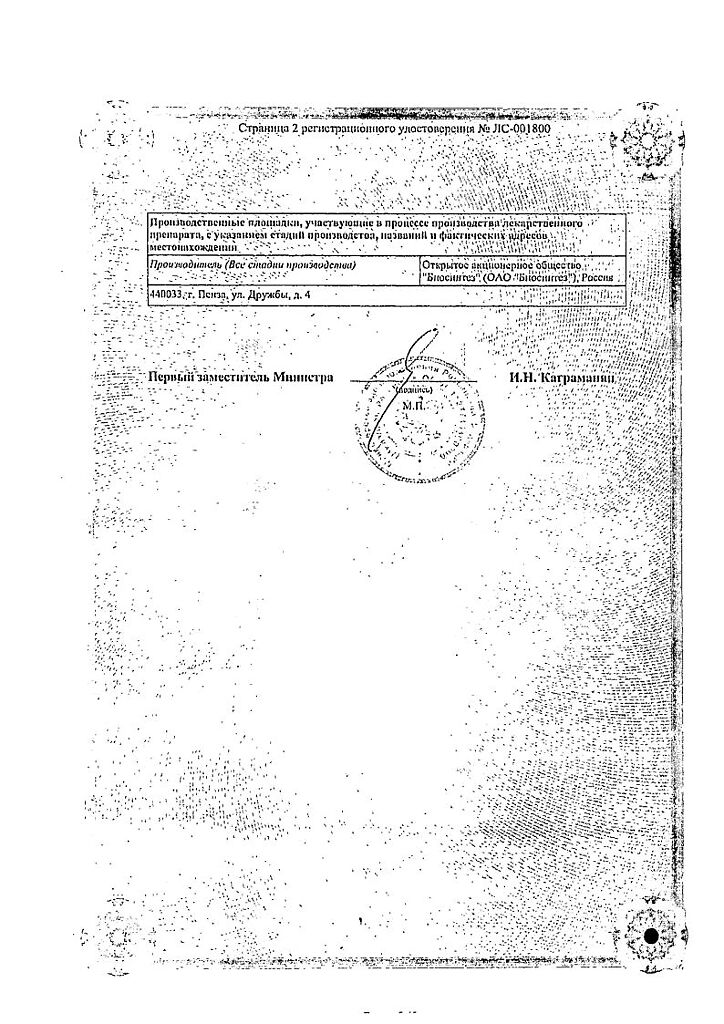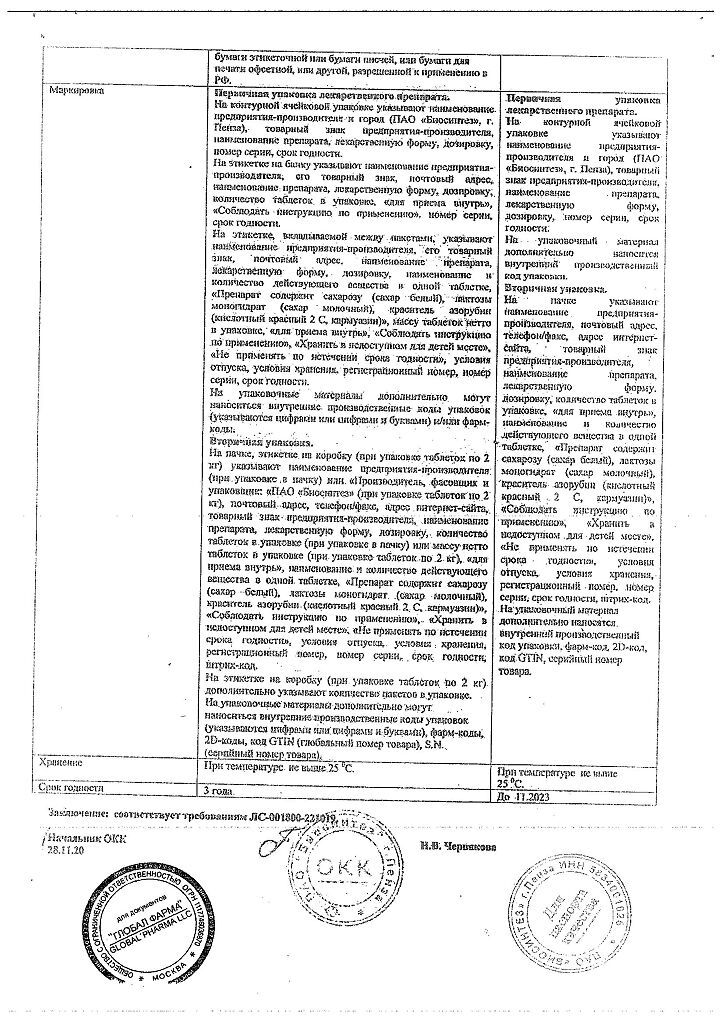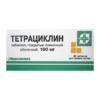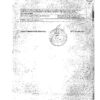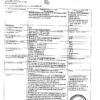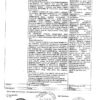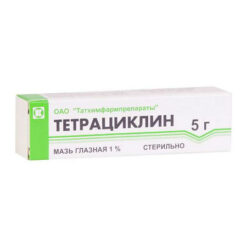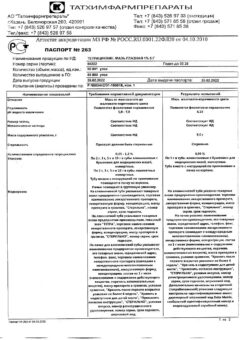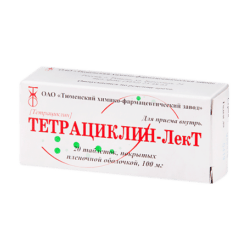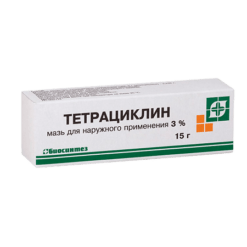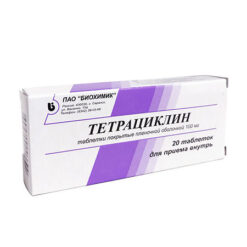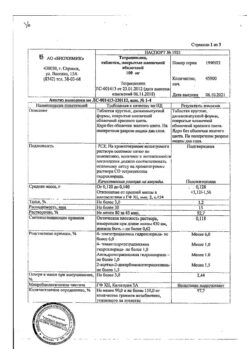No products in the cart.
Tetracycline, 100 mg 20 pcs.
€6.12 €5.44
Description
Pharmacotropic group: antibiotic, tetracycline.
TATX code: [J01AA07].
Pharmacokinetics
Absorption – 75-77%, decreases with food, binding to plasma proteins – 55-65%.
The time to reach maximum concentration when taken orally is 2-3 hours (it may take 2-3 days to reach therapeutic concentration). Over the next 8 hours the concentration gradually decreases. Maximum concentration is 1.5-3.5 mg/l (a concentration of 1 mg/l is sufficient to achieve therapeutic effect).
In the body it is distributed unevenly: the maximum concentration is contained in the liver, kidneys, lungs and in organs with a well developed reticuloendothelial system – spleen, lymph nodes. The concentration in bile is 5-10 times higher than in blood serum. In thyroid and prostate tissues tetracycline content is the same as in plasma; in pleural, ascitic fluid, saliva, milk of lactating women – 60-100% concentration in plasma. It accumulates in large quantities in bone tissue, tumor tissues, dentin and enamel of deciduous teeth. It penetrates poorly through the blood-brain barrier. In intact cerebral membranes in the cerebrospinal fluid is not determined or detected in insignificant amounts (5-10% of the concentration in plasma). In patients with diseases of the central nervous system, especially in inflammatory processes in the brain membranes, the concentration in cerebrospinal fluid is 8-36% of the plasma concentration. It penetrates through the placental barrier and into breast milk. Volume of distribution is 1.3-1.6 l/kg.
It is slightly metabolized in the liver. The elimination half-life is 6-11 hours; in anuria it is 57-108 hours. It is detected in high concentration in urine within 2 hours after intake and retained for 6-12 hours; during the first 12 hours up to 10-20% of dose is excreted by kidneys. Smaller amounts (5-10% of the total dose) are excreted with bile in the intestine, where it is partially reabsorbed, which allows for prolonged circulation of the active substance in the body (intestine-hepatic circulation). Excretion through the intestine is 20-50%. With hemodialysis it is removed slowly.
Pharmacodynamics
Bacteriostatic antibiotic of tetracycline group. It disrupts formation of the complex between transport RNA and ribosome, which leads to suppression of protein synthesis.
Active against Gram-positive microorganisms – Staphylococcus spp. (including Staphylococcus aureus, including penicillinase-producing strains), Streptococcus spp. (some strains, including Streptococcus pneumoniae), Listeria monocytogenes, Bacillus anthracis, Clostridium spp, Actinomyces spp., Propionibacterium acnes, Bacillus fusiformis;
Gram-negative microorganisms – Haemophilus influenzae, Haemophilus ducreyi, Bordetella pertussis, Escherichia coli, Enterobacter spp. (including Enterobacter aerogenes), Klebsiella spp, Neisseria gonorrhoeae, Shigella spp, Yersinia pestis, Bartonella bacilliformis, Vibrio cholerae, Vibrio fetus, Rickettsia prowazekii, Rickettsia rickettsii, Rickettsia akari, Borrelia Vinceni, Borrelia recurrentis, Borrelia burgdorferi, Brucella spp. (in combination with streptomycin); Calymmatobacterium granulomatis, Francisella tularensis, Treponema pallidum, Treponema pertenue;
In case of contraindications to the administration of penicillins – Clostridium spp, Neisseria gonorrhoeae, Actinomyces spp;
Active against Chlamydia trachomatis; Chlamydia psittaci, Entamoeba histolytica;
Tetracycline-resistant microorganisms: Pseudomonas aeruginosa, Proteus spp; Serratia spp, most strains of Bacteroides spp. and fungi, viruses, group A beta-haemolytic streptococci (including 44% of Streptococcus pyogenes strains and 74% of Streptococcus faecalis strains).
Indications
Indications
Infectious and inflammatory diseases caused by microorganisms sensitive to tetracycline: pneumonia and respiratory tract infections caused by Mycoplasma pneumoniae, respiratory tract infections caused by Haemophilus influenzae and Klebsiella spp., bacterial infections of the genitourinary organs, infections of the skin and soft tissues, ulcerative necrotizing gingivostomatitis, conjunctivitis, acne, actinomycosis, intestinal amebiasis, anthrax, brucellosis, bartonellosis, chancroid, cholera, chlamydia, uncomplicated gonorrhea, granuloma inguinale, lymphogranuloma venereum, listeriosis, plague, psittacosis, vesicular rickettsiosis, Rocky Mountain spotted fever, typhus, relapsing fever, syphilis, trachoma, tularemia, yaws, botulism, tetanus, gas gangrene, foodborne illness, whooping cough, dysentery, vibriosis, Lyme disease.
Pharmacological effect
Pharmacological effect
Pharmacotherapeutic group: antibiotic, tetracycline.
ATX code: [J01AA07].
Pharmacokinetics
Absorption – 75-77%, decreases with food intake, binding to plasma proteins – 55-65%.
The time to reach maximum concentration after oral administration is 2–3 hours (it may take 2–3 days to reach therapeutic concentrations). Over the next 8 hours, the concentration gradually decreases. The maximum concentration is 1.5–3.5 mg/l (a concentration of 1 mg/l is sufficient to achieve a therapeutic effect).
It is distributed unevenly in the body: in maximum concentration it is found in the liver, kidneys, lungs and in organs with a well-developed reticuloendothelial system – the spleen, lymph nodes. The concentration in bile is 5–10 times higher than in blood serum. In the tissues of the thyroid and prostate glands, the content of tetracycline is the same as in plasma; in pleural, ascitic fluid, saliva, milk of lactating women – 60–100% of the concentration in plasma. It accumulates in large quantities in bone tissue, tumor tissue, dentin and enamel of baby teeth. Penetrates poorly through the blood-brain barrier. With intact meninges, it is not detected in the cerebrospinal fluid or is detected in small quantities (5–10% of the plasma concentration). In patients with diseases of the central nervous system, especially with inflammatory processes in the meninges, the concentration in the cerebrospinal fluid is 8–36% of the plasma concentration. Penetrates through the placental barrier and into breast milk. Volume of distribution – 1.3–1.6 l/kg.
Slightly metabolized in the liver. The half-life is 6-11 hours, with anuria – 57-108 hours. It is found in urine in high concentrations 2 hours after administration and persists for 6-12 hours; in the first 12 hours, up to 10–20% of the dose is excreted by the kidneys. In smaller quantities (5–10% of the total dose) it is excreted with bile into the intestine, where partial reabsorption occurs, which promotes long-term circulation of the active substance in the body (enterohepatic circulation). Excretion through the intestines is 20–50%. During hemodialysis it is removed slowly.
Pharmacodynamics
Bacteriostatic antibiotic from the tetracycline group. It disrupts the formation of a complex between transfer RNA and the ribosome, which leads to suppression of protein synthesis.
Active against gram-positive microorganisms – Staphylococcus spp. (including Staphylococcus aureus, including penicillinase-producing strains), Streptococcus spp. (some strains, including Streptococcus pneumoniae), Listeria monocytogenes, Bacillus anthracis, Clostridium spp., Actinomyces spp., Propionibacterium acnes, Bacillus fusiformis;
Gram-negative microorganisms – Haemophilus influenzae, Haemophilus ducreyi, Bordetella pertussis, Escherichia coli, Enterobacter spp. (including Enterobacter aerogenes), Klebsiella spp., Neisseria gonorrhoeae, Shigella spp., Yersinia pestis, Bartonella bacilliformis, Vibrio cholerae, Vibrio fetus, Rickettsia prowazekii, Rickettsia rickettsii, Rickettsia akari, Borrelia Vinceni, Borrelia recurrentis, Borrelia burgdorferi, Brucella spp. (in combination with streptomycin); Calymmatobacterium granulomatis, Francisella tularensis, Treponema pallidum, Treponema pertenue;
For contraindications to the use of penicillins – Clostridium spp., Neisseria gonorrhoeae, Actinomyces spp.;
Active against Chlamydia trachomatis; Chlamydia psittaci, Entamoeba histolytica;
Microorganisms resistant to tetracycline: Pseudomonas aeruginosa, Proteus spp.; Serratia spp., most strains of Bacteroides spp. and fungi, viruses, group A beta-hemolytic streptococci (including 44% of Streptococcus pyogenes strains and 74% of Streptococcus faecalis strains).
Special instructions
Special instructions
Due to the possible development of photosensitivity, it is necessary to limit insolation.
With long-term use, periodic monitoring of the function of the kidneys, liver, and hematopoietic organs is necessary.
It can mask the manifestations of syphilis, and therefore, if a mixed infection is possible, monthly serological analysis is necessary for 4 months.
All tetracyclines form stable complexes with calcium ions in any bone-forming tissue. In this regard, intake during the period of tooth development can cause long-term staining of teeth in a yellow-gray-brown color, as well as enamel hypoplasia.
To prevent hypovitaminosis, vitamins B and K and brewer’s yeast should be prescribed.
Impact on the ability to drive vehicles or potentially dangerous mechanisms
There is no data on the effect on reaction speed when driving vehicles or working with machinery.
Active ingredient
Active ingredient
Tetracycline
Composition
Composition
One tablet contains:
Active ingredient:
Tetracycline hydrochloride (in terms of active ingredient) – 100.00 mg.
Excipients:
Sucrose (white sugar), calcium stearate, talc, gelatin, potato starch.
Film casing:
Hypromellose (hydroxypropyl methylcellulose), lactose monohydrate (milk sugar), polysorbate 80 (Tween 80), azorubine dye (acid red 2C, carmoisine).
Pregnancy
Pregnancy
Contraindicated during pregnancy (tetracyclines pass through the placenta, accumulate in the bones and tooth buds of the fetus, disrupting their mineralization, and can cause severe disorders of developed bone tissue).
FDA category of effect on the fetus is D.
During treatment, it is necessary to stop breastfeeding (tetracyclines pass into breast milk and can adversely affect the development of the baby’s bones and teeth, as well as cause photosensitivity reactions, oral and vaginal candidiasis in infants).
Contraindications
Contraindications
Hypersensitivity to tetracycline and drug components, pregnancy, breastfeeding, children (up to 8 years), leukopenia, sucrase/isomaltase deficiency, fructose intolerance, glucose-galactose malabsorption, renal failure, liver dysfunction.
Side Effects
Side Effects
From the digestive system: loss of appetite, vomiting, diarrhea, nausea, glossitis, esophagitis, gastritis, ulceration of the stomach and duodenum, hypertrophy of the papillae of the tongue, dysphagia, hepatotoxic effect, pancreatitis, intestinal dysbiosis, enterocolitis, increased activity of “liver” transaminases, antibiotic-associated diarrhea.
From the central nervous system: increased intracranial pressure, headache, toxic effects on the central nervous system (dizziness or instability).
From the hematopoietic organs: hemolytic anemia, thrombocytopenia, neutropenia, eosinophilia.
From the urinary system: azotemia, hypercreatininemia, nephrotoxic effect.
Allergic and immunopathological reactions: maculopapular rash, skin hyperemia, angioedema, anaphylactoid reactions, drug-induced systemic lupus erythematosus, photosensitivity.
Other: superinfection, candidiasis, hypovitaminosis of B vitamins, hyperbilirubinemia, discoloration of tooth enamel in children, stomatitis.
Interaction
Interaction
Due to the suppression of intestinal microflora, it reduces the prothrombin index (requires a reduction in the dose of indirect anticoagulants).
Reduces the effectiveness of bactericidal antibiotics that disrupt cell wall synthesis (penicillins, cephalosporins).
Reduces the effectiveness of estrogen-containing oral contraceptives and increases the risk of breakthrough bleeding; retinol – risk of developing increased intracranial pressure.
Absorption is reduced by antacids containing aluminum, magnesium and calcium, iron supplements and cholestyramine.
Chymotrypsin increases the concentration and duration of circulation.
Overdose
Overdose
Increased dose-dependent side effects are possible.
Treatment: symptomatic therapy.
Storage conditions
Storage conditions
In a dry place at a temperature not exceeding 25 °C. Out of reach of children
Shelf life
Shelf life
3 years
Manufacturer
Manufacturer
Biosynthesis, Russia
Additional information
| Shelf life | 3 years |
|---|---|
| Conditions of storage | In a dry place at a temperature not exceeding 25 °С. Out of the reach of children |
| Manufacturer | Biosintez, Russia |
| Medication form | pills |
| Brand | Biosintez |
Other forms…
Related products
Buy Tetracycline, 100 mg 20 pcs. with delivery to USA, UK, Europe and over 120 other countries.

